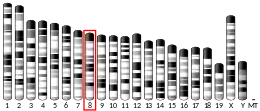| THSD1 | |||||||||||||||||||||||||||||||||||||||||||||||||||
|---|---|---|---|---|---|---|---|---|---|---|---|---|---|---|---|---|---|---|---|---|---|---|---|---|---|---|---|---|---|---|---|---|---|---|---|---|---|---|---|---|---|---|---|---|---|---|---|---|---|---|---|
| Identifiers | |||||||||||||||||||||||||||||||||||||||||||||||||||
| Aliases | THSD1, TMTSP, UNQ3010, thrombospondin type 1 domain containing 1, ANIB12 | ||||||||||||||||||||||||||||||||||||||||||||||||||
| External IDs | OMIM: 616821 MGI: 1929096 HomoloGene: 10264 GeneCards: THSD1 | ||||||||||||||||||||||||||||||||||||||||||||||||||
| |||||||||||||||||||||||||||||||||||||||||||||||||||
| |||||||||||||||||||||||||||||||||||||||||||||||||||
| |||||||||||||||||||||||||||||||||||||||||||||||||||
| |||||||||||||||||||||||||||||||||||||||||||||||||||
| Wikidata | |||||||||||||||||||||||||||||||||||||||||||||||||||
| |||||||||||||||||||||||||||||||||||||||||||||||||||
Thrombospondin type-1 domain-containing protein 1 is a protein that in humans is encoded by the THSD1 gene.[5]
The protein encoded by this gene contains a type 1 thrombospondin domain, which is found in thrombospondin, a number of proteins involved in the complement pathway, as well as extracellular matrix proteins. Alternatively spliced transcript variants encoding distinct isoforms have been observed.[5]
References
- 1 2 3 GRCh38: Ensembl release 89: ENSG00000136114 - Ensembl, May 2017
- 1 2 3 GRCm38: Ensembl release 89: ENSMUSG00000031480 - Ensembl, May 2017
- ↑ "Human PubMed Reference:". National Center for Biotechnology Information, U.S. National Library of Medicine.
- ↑ "Mouse PubMed Reference:". National Center for Biotechnology Information, U.S. National Library of Medicine.
- 1 2 "Entrez Gene: THSD1 thrombospondin, type I, domain containing 1".
Further reading
- Bork P (1993). "The modular architecture of a new family of growth regulators related to connective tissue growth factor". FEBS Lett. 327 (2): 125–30. doi:10.1016/0014-5793(93)80155-N. PMID 7687569.
- Gruber HE, Ingram JA, Hanley EN (2007). "Immunolocalization of thrombospondin in the human and sand rat intervertebral disc". Spine. 31 (22): 2556–61. doi:10.1097/01.brs.0000241117.31510.e3. PMID 17047544. S2CID 43521262.
- Gerhard DS, Wagner L, Feingold EA, et al. (2004). "The Status, Quality, and Expansion of the NIH Full-Length cDNA Project: The Mammalian Gene Collection (MGC)". Genome Res. 14 (10B): 2121–7. doi:10.1101/gr.2596504. PMC 528928. PMID 15489334.
- Orr AW, Pallero MA, Xiong WC, Murphy-Ullrich JE (2005). "Thrombospondin induces RhoA inactivation through FAK-dependent signaling to stimulate focal adhesion disassembly". J. Biol. Chem. 279 (47): 48983–92. doi:10.1074/jbc.M404881200. PMID 15371459.
- Dunham A, Matthews LH, Burton J, et al. (2004). "The DNA sequence and analysis of human chromosome 13". Nature. 428 (6982): 522–8. Bibcode:2004Natur.428..522D. doi:10.1038/nature02379. PMC 2665288. PMID 15057823.
- Ota T, Suzuki Y, Nishikawa T, et al. (2004). "Complete sequencing and characterization of 21,243 full-length human cDNAs". Nat. Genet. 36 (1): 40–5. doi:10.1038/ng1285. PMID 14702039.
- Clark HF, Gurney AL, Abaya E, et al. (2003). "The Secreted Protein Discovery Initiative (SPDI), a Large-Scale Effort to Identify Novel Human Secreted and Transmembrane Proteins: A Bioinformatics Assessment". Genome Res. 13 (10): 2265–70. doi:10.1101/gr.1293003. PMC 403697. PMID 12975309.
- Strausberg RL, Feingold EA, Grouse LH, et al. (2003). "Generation and initial analysis of more than 15,000 full-length human and mouse cDNA sequences". Proc. Natl. Acad. Sci. U.S.A. 99 (26): 16899–903. Bibcode:2002PNAS...9916899M. doi:10.1073/pnas.242603899. PMC 139241. PMID 12477932.
This article is issued from Wikipedia. The text is licensed under Creative Commons - Attribution - Sharealike. Additional terms may apply for the media files.




